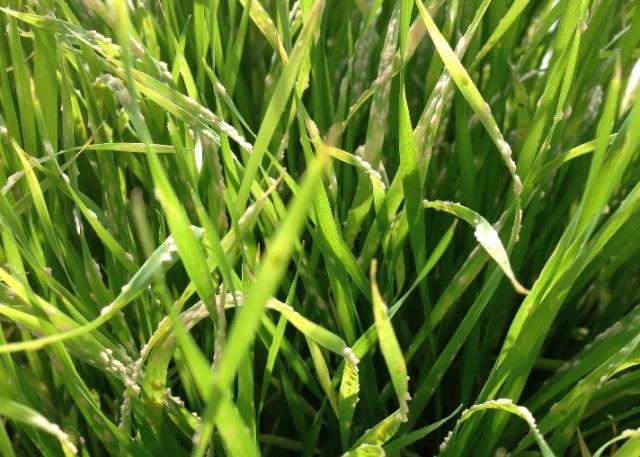Environmental, crop nutrition and pathogen virulence factors influencing wheat powdery mildew in Western Australia
What is wheat powdery mildew and how does it impact on WA crops?
Wheat powdery mildew (WPM) is a fungal leaf disease that occurs worldwide in wheat growing areas with temperate maritime climates. It is caused by the fungus Blumeria graminis f.sp tritici and is favoured by stubble retention, high seeding and nitrogen fertiliser rates and large areas being planted with susceptible varieties. In Australia it can cause yield losses of up to 25%.
WPM is sensitive to environmental conditions and can vary from season to season. Changing temperature and relative humidity will alter the speed of the disease life cycle, infection success and spread on susceptible crops. Control can be complicated due to the multiple, rapid life cycles (5-12 days) and the wide dispersal of numerous small, light, wind-borne spores.
Symptoms of wheat powdery mildew
Powdery mildew appears as fluffy, white powdery growths of fungal spores on the leaf surface. Young, succulent growth such as new tillers is usually more susceptible than older plant tissues. Symptoms progress from lower to upper leaves. Under severe disease pressure as the season progresses, the fluffy, white powdery growth can also affect stems and heads.
Fungal colonies eventually enlarge and merge together. The area surrounding the lesion and on the reverse side of the leaf turns yellow to brown. Moderate to severe infections can result in leaf death. Older infections on leaves and heads turn grey and can develop black fruiting bodies, called chasmothecia (formerly cleistothecia), which appear as black specks. The disease survives over summer as chasmothecia, which form and release ascospores when temperature and humidity are conducive.

A powdery mildew infected crop will appear yellow from a distance, similar to a crop suffering from water logging or nutrient deficiency. Therefore, close examination is needed to avoid mistaken diagnosis. For more information refer to Managing powdery mildew in wheat.
Investigating WPM virulence spectrum
Understanding the diversity of powdery mildew pathotypes (virulence frequencies) in WA is important in the development of wheat lines with effective, enduring resistance and for management of existing commercial varieties.
To better understand the diversity of powdery mildew pathotypes (virulence frequencies) in WA, DPIRD plant pathologists Jason Bradley and Geoff Thomas collected WPM samples from 31 locations across the WA wheatbelt in 2016 and 2017. Each sample was stored and bulked up in isolation to maintain purity. All samples were screened in a glasshouse against a differential set of wheat lines with known resistance genes, and a set of commercial varieties with varying resistance levels to WPM.
All commercial wheat varieties tested were susceptible as seedlings to all powdery mildew isolates collected from across the wheatbelt. There was no definitive regional specialisation of mildew isolates, but minor differences in seedling response were noted from wheat lines carrying known mildew resistance genes, indicating that some variability in virulence is present in the WPM population (also reported by Golzar et al., 2016). Both studies found that there were resistance genes, not in commercial varieties, effective both at seedling and adult stage to collected isolates. Resistance that occurred only at the adult stage was also identified.
However, until varieties with improved resistance are released, placing selection pressure on the powdery mildew population, variety responses should be consistent across the wheatbelt and reflect NVT disease ratings.
For more information refer to 2019 Wheat Powdery Mildew epidemiology and crop management options. GRDC Grains Research Update or Golzar, H., Shankar, M., and D’Antuono, M. (2016) Responses of commercial wheat varieties and differential lines to western Australian powdery mildew (Blumeria graminis f. Sp. tritici) populations. Australasian Plant Pathology 45:347-355.
The effects of varying temperature on WPM
Parameters favouring WPM can be used to identify the periods of increased epidemic risk and guide the need for management intervention in the different climatic regions of the WA wheatbelt.
DPIRD plant pathologist Jason Bradley investigated the effect of various temperatures on WPM by carrying out controlled environment experiments in 2016. The impact of temperatures ranging from 5 to 25°C was observed on WPM infection in Wyalkatchem wheat, infected with WPM isolates collected from DPIRD’s Geraldton research station in 2016. Wyalkatchem wheat is rated susceptible (S) to very susceptible (SVS) to WPM. Germination of inoculated spores, lesion development, presence of sporulation and disease severity was observed.
Temperature can impact the number of successful infections, the speed at which infection progresses, the sporulation of the fungus and the survival of the fungus. At cooler temperatures, infection and disease expression are significantly slower and the rate of sporulation is slower, however a similar maximum level of infection / sporulation is reached but at a later time. At temperatures around 20°C, Jason found the infection was optimum, the latent period (time to the start of sporulation) was ~4 days and disease severity was greatest (Figure 2). Decreasing temperature to 10°C doubled the latent period (~8 days) and reduced sporulation after 12 days by more than 90%. At 10°C or lower temperatures, disease severity and sporulation reached similar levels to plants infected at 20°C but the time period to reach these levels was as much as doubled.
At temperatures above 20°C, a more severe impact was evident. A sharp decline in infection was evident at temperatures over 23°C, with infection not occurring at 25°C (Figure 2).


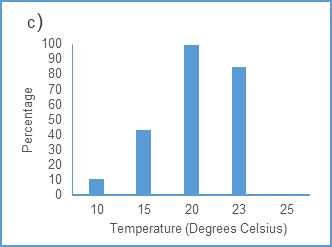
For plants infected under ideal conditions (20ºC), exposure to 25ºC for periods of time immediately post inoculation (prior to returning to 20 ºC) progressively delayed and reduced severity of infection on seedlings and leaf fragments compared to the 20ºC control (Figure 3). Six and 12 hours exposure reduced infection severity by 15% while 24 and 30 hours exposure significantly reduced severity at all times of assessment compared to the control.
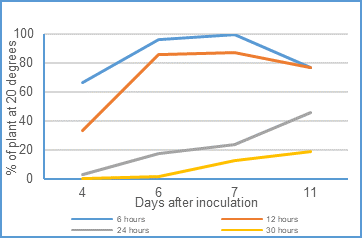
The main findings from this experiment are that
- Under high humidity (>95%), a temperature of 20-22°C is optimum for infection and rapid development of most severe infection and abundant sporulation
- At temperatures of <15°C, viability of the fungus and success of infection remain high, however the disease progress is slowed significantly (including time to reach maximum sporulation)
- At temperatures >23°C and specifically at 25°C, infection is retarded, sporulation is reduced and survival of spores is diminished
So what does this mean………
-
The northern wheatbelt of WA with warm daytime temperatures and mild night temperatures during winter and early spring are ideal for WPM development. However as spring becomes warmer and days >23°C occur, a sharp drop off of the epidemic can be expected. Given the more rapid growth of wheat in this environment, rapid advancement of the disease from lower canopy to flag leaf and head can occur during the growing season, however infection can quickly be retarded by the onset of warmer weather.
-
In the central and southern wheatbelt, with winter temperatures <15°C, survival of WPM is supported however disease progress is slower. Epidemics of WPM are likely to be slow to develop however with warming spring weather (20°C) multiplication of the epidemic can be significant and rapid.
-
In environments such as parts of the Esperance zone, mild conditions can support winter epidemic development and slower onset of high spring temperatures can extend exposure to the epidemic. This has been reflected in epidemic development observed in recent seasons
Growth stage impact on disease severity
To investigate whether growth stage at time of infection impacts on WPM severity, DPIRD conducted a trial in controlled environment conditions (average 17oC), with three varieties (Scepter SVS, Mace MSS, Magenta MR) being sown in pots at three times to achieve three growth stages (~Z13, Z32, Z43). All plants were inoculated with a WPM isolate from DPIRD Geraldton research station on the same day. Plants were assessed for leaf area affected by mildew on the top three fully expanded leaves 14 days after inoculation.
Susceptible (Scepter ) and moderately susceptible to susceptible (Mace ) plants inoculated at Z13 and Z31 developed significantly greater severity of disease compared to those inoculated at Z43. Moderately resistant Magenta exhibited low levels of disease at the seedling stage but had significantly less disease than Scepter or Mace at all growth stages (Figure 4).

In summary disease onset at early growth stages magnifies the risk of powdery mildew in susceptible varieties, effectively rendering plants more susceptible. Younger, faster growing plant tissue also has higher carbohydrate levels which is a food source for the mildew.
So what does this mean………
- In environments where mildew can be expected to be present early in the season, the crop will be at its most susceptible and as such use of an upfront fungicide/seed dressing can be a useful approach to limit epidemic development.
- While showing a similar trend to higher disease at early growth stages, the MR type Magenta had significantly less disease than MSS and S types, showing that variety resistance remains an effective tool for limiting early season epidemics.
Nitrogen and potassium nutrition influence on WPM
Nitrogen and potassium application has been shown to influence disease severity. How these nutrients influence a crop’s susceptibility to WPM will influence integrated disease management (IDM) practices.
Field trials to examine impact of nitrogen and potassium nutrition on WPM development and severity were carried out as individual experiments at DPIRD’s Medina Research station in 2017 (Scepter , Zen , Mace , Tungsten , Magenta ) and UWA’s Shenton Park field station in 2018 (Scepter , Mace , Magenta ).
Fertiliser applications were applied up to three times in the season (0, 3 and 6 weeks after sowing). Nitrogen was added as urea, and potassium as muriate of potash. Powdery mildew was introduced by natural spread from inoculated susceptible spreader rows adjacent to each plot. Disease severity was measured as leaf area affected by WPM in 5 replicate plants per plot on a fortnightly basis from Z39 (flag leaf emergence).
Glasshouse experiments in 2017 and 2018 were carried out under controlled environment conditions using similar varieties to field experiments. Plants were sown into coarse river sand with nitrogen and potassium as liquid formulation applied at up to 3 times to achieve the desired application rate. Plants were inoculated by dusting with WPM spores at Z13 (3-4 leaf stage) and disease severity assessed as leaf area on top 3 leaves affected by WPM at stem elongation (~Z31-32) and full head emergence (~Z59-65), 21 and 42 days after inoculation.
Nitrogen
In three out of four experiments, WPM severity was greater with higher rates of applied nitrogen fertiliser. Variations in starting soil nitrogen concentration and seasonal conditions meant that establishing a consistent threshold application level was not possible. At Medina (2017) severity of wheat powdery mildew in susceptible varieties Scepter and Mace increased with increasing application rate up to the ‘luxury’ rate (120 kg/ha). Disease severity in Magenta (MRMS) did not respond to nitrogen rate (data not shown). Similarly at Shenton Park in 2018, increasing nitrogen application resulted in greater WPM severity in the susceptible varieties but not significantly so in Magenta , despite growth in all varieties being nitrogen responsive, having increased NDVI readings (indicative of plant density and plant greenness) and yield at increasing rates (Figure 5 a, b, c).


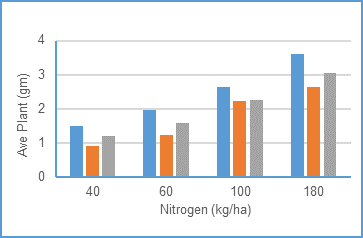
Replicating the field responses, in glasshouse studies disease responses in Magenta were minor, however in the susceptible varieties Mace and Scepter , significant differences were evident between nitrogen rates. At inadequate and low rates, plants suffered nitrogen deficiency symptoms and disease levels were negligible. At adequate and luxury levels, plants were healthy and disease severity showed a significant increasing trend (Figure 6). With glasshouse trial design eliminating canopy impacts of higher nitrogen rates, this result indicates nitrogen was directly influencing plant disease response.
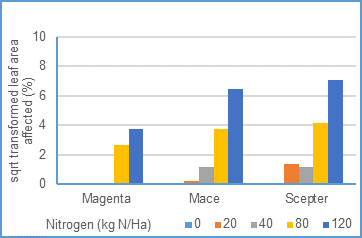
What does this mean…..
- In circumstances where the plant is still responsive to nitrogen (NDVI response), as nitrogen rate increases, powdery mildew susceptibility also increases. The glasshouse trial has shown that this response is due to the actual plant being more sensitive to the disease.
- Nitrogen causes: plants to grow faster, leaves to be broader and the canopy to be denser. The direct impact of nitrogen on plants also makes the plant more susceptible, with an increased amount of younger tissue (new growth) being more susceptible to the disease. Indirect impacts of N on canopy density, humidity and temperature were not evaluated but will also favour WPM development.
- It is important to manage crops for maximum return on investment from nitrogen, however in high input systems this will result in crops being more susceptible to WPM. Where additional N is unlikely to provide yield / protein benefit then not it may provide marginal WPM management benefit
- Additional N did not reduce resistance of MR type variety
Potassium
Significant impact of application rates of muriate of potash on wheat powdery mildew were evident at only two of four experiments (Medina 2017 and Perth glasshouse 2018). Baseline soil potassium concentrations in trials were only marginally below recommended thresholds and establishment of potassium deficiency was problematic. Response to potassium is inverse of nitrogen response, so a greater disease severity occurs when potassium is deficient.
In 2017, moderately severe WPM was present in all plots, however disease severity in three of five varieties (Magenta , Tungsten , Zen ) was marginally higher (10-15%) at inadequate potassium concentration (of 20 and 40kg applied) compared to adequate (80 and 160kg applied).
Similarly, in the 2018 glasshouse experiment, under high disease pressure, two varieties (Mace and Wyalkatchem ) showed significant difference in disease severity (10-15%) between minimum and maximum fertiliser treatments (Figure 7).
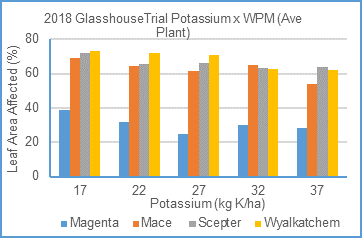
What does this mean…
- Potassium may have a marginal impact on disease response however the degree of response is of lesser magnitude than for nitrogen
- Potassium is not a fungicide
- Manage potassium nutrition to optimise plant growth, though additional applications are unlikely to provide additional benefit
Managing WPM
The dominance of susceptible varieties (e.g. Mace and now Scepter) has placed very little selection pressure on the WPM population in WA and correspondingly only a small proportion of tested wheat lines (resistance genes) showed differential responses between isolates. Until new seedling resistance genes are widely deployed placing greater selection pressure on the population, variety responses should remain constant across the wheatbelt and management should reflect the NVT ratings.
These DPIRD experiments have shown that factors such as optimum nitrogen nutrition and disease onset at early growth stages magnify risk of powdery mildew in susceptible varieties, effectively rendering plants more susceptible.
The use of seed dressings and in-furrow fungicides has been shown to effectively delay powdery mildew onset (Thomas et al. 2017) and may be of extra benefit where early onset of disease at more susceptible growth stages is expected (e.g. green bridge years), or when higher rates of nitrogen are applied at early growth stages. At later growth stages, high nitrogen status can result in greater susceptibility of plants and denser canopies, increasing disease severity and potentially placing greater pressure on fungicide efficacy.
Understanding environmental drivers of disease risk can provide guidance on how disease may develop in different regions of WA and potentially how fungicide programs might be tailored to suit how epidemics develop in these regions. In environments that have temperatures between 15-22°C powdery mildew survival, infection and disease progress are maximised. In a typical year, with inoculum present, northern growing regions are at risk of experiencing the earliest outbreaks of WPM in the WA wheatbelt. For Geraldton, peak rainfall is in June-July, with optimum daily conditions averaging 20-21oC and nights averaging 10-11oC, making an ideal environment for a rapid lifecycle of WPM. Epidemics will spread quickly in susceptible varieties in June - August, and fungicide management timed to limit this rapid disease development is important. However the onset of warmer weather can cause a rapid end to epidemics potentially limiting the need for later season management. By September rainfall decreases (lowering canopy humidity) and the number of days over 25oC increases markedly (e.g.14 days in 2015) reducing likelihood of successful WPM infection and disease spread.
In contrast, regions south of Perth, such as Katanning, are likely to have epidemics developing later in the season. Winter is significantly cooler in these regions (av. day temp 15oC and night 5-6oC) resulting in a longer latent period and decreased sporulation but more suitable temperatures that persist longer into spring with rainfall maintained, and fewer days over 25oC. It is likely that under these cool winter conditions, the need for prophylactic protection may be less important but the capacity to respond to spring epidemics is more important.
The Esperance region has seen significant disease outbreaks in several years, early disease development is favoured by mild April and May conditions with few days over 25 degrees. Peak rain is July-August with optimum temperatures (including few days over 25oC) continuing into October. This environment appears to have the greatest span of favourable weather conditions for the disease with mildew developing rapidly in spring and affecting both foliage and heads of susceptible varieties. In these environments, weather conditions are conducive for infection for a significant period of the season meaning management intervention can be needed throughout the cropping cycle.

